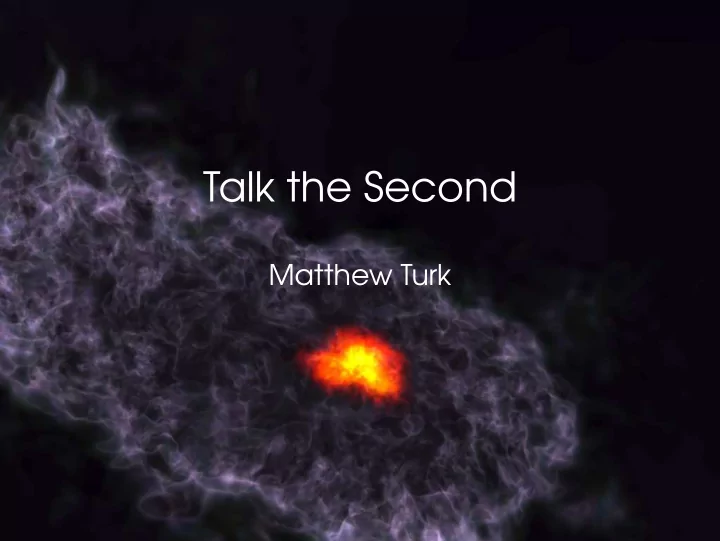

Talk the Second Matthew Turk
◮ Questions ◮ Collaborations ◮ Future directions ◮ yt Survival Guide
◮ Questions ◮ Collaborations ◮ Future directions ◮ yt Survival Guide
Kinds of questions
What can we ask of our data?
Three basic categories:
◮ Simple questions ◮ Hard questions ◮ Impossible questions
◮ Simple questions ◮ Hard questions ◮ Impossible questions
Asking a (Simple) Question
The data and the tools already exist.
Steps 1. Ask the physical question 2. Formulate this question in terms of data 3. Position the question in terms of tools
Requires an understanding of availability and methodology .
(review of PopIII stars)
Two Questions: 1. Where are the hot bubbles located in my simulations? 2. What is the morphology of the fragmenting region?
Hot Bubbles
◮ The gas in some regions seems to be hotter than others ◮ How do I identify hot regions using their properties? ◮ How do I persuade yt to tell me about those regions?
“One red thread.”
Morphology
800 AU
◮ The molecular cloud has split in two ◮ At what densities do the ◮ How do I persuade yt to tell me about those regions?
10 -16 g/cc
10 -14 g/cc
10 -12 g/cc
Asking a (Hard) Question
Steps 1. Ask the physical question 2. Formulate this question in terms of data 3. Ask why existing tools do not satisfy this answer 4. Iterate on algorithms and implementations
◮ The cloud has broken up! ◮ How do I identify one region that’s not connected to another? ◮ The clouds it broke into aren’t regular shapes. ◮ Let’s try to identify connected sets.
Level Sets
◮ Identify connected sets in grids ◮ Connect sets across grids ◮ Coalesce
Impossible Questions
“All those moments will be lost in time... Like tears in rain...” – Roy Batty
Design questions in advance.
In situ can only sip from the firehose.
On Disc → In-situ
◮ Questions ◮ Collaborations ◮ Future directions ◮ yt Survival Guide
Project Collaborations
“Co-opetition”
What has worked for yt ? ◮ Communication ◮ Investment ◮ Rewards ◮ Letting Go
2
Bifurcate Communication
2
2
Investment
Investment
(Show 5 Mpc density movie)
Case Study: Volume Rendering
Meeting a need.
(Pragmatic development)
Timeline 1. Late 2009: Developed stacked cutting planes 2. Late 2009: Homogenized Volumes 3. Early 2010: Image plane parallelism 4. Mid 2010: Multivariate transfer functions 5. Early 2011: kD-tree 6. Early 2012: Threading
As responsibility and pride grew, development blossomed as well.
Rewards
De facto and de jure
De facto rewards ◮ Utilization of developed tools ◮ Respect from community ◮ Involvement in projects ◮ Invitations to speak
De jure rewards ◮ Funding ◮ Additional publications ◮ Citations
The reward structure in astrophysics does not favor builders.
Letting Go
Too much control leads to smothering growth.
Allow projects to pass between people.
Encourage pride , but not ownership .
◮ Questions ◮ Collaborations ◮ Future directions ◮ yt Survival Guide
Geometry
Generic geometric selection of points, cells and data
IO Library
Regularization occurs inside yt natively. Serialize this to disk.
Tighter Integration
Initialization sim = NewMesh([64, 64, 64]) sim.add_fluid("density") sim.add_fluid("hydrogen", color=True, frac=0.76) sim.set_temperature(100) sim.set_density(1e-3) sphere = add_sphere([0.5, 0.5, 0.5], 0.1) sphere.set_temperature(1000) sphere.set_density(1e0) sim.run()
Simulation Control sim.add_module("hydro_HLLC") sim.add_module("chemistry_high_density") sim.run()
Collaboration
hub.yt-project.org
Better Outreach
◮ Questions ◮ Collaborations ◮ Future directions ◮ yt Survival Guide
Survival Guide http://yt-project.org/ : Docs, bug reports, help yt help yt plot yt upload_image yt serve yt mapserver
Recommend
More recommend